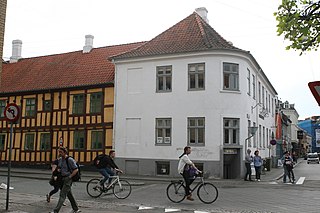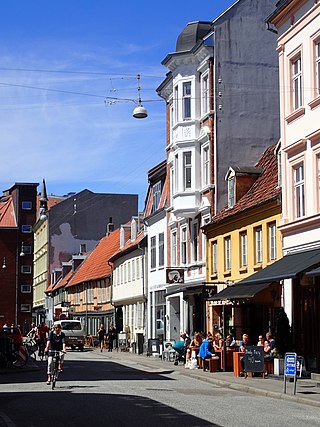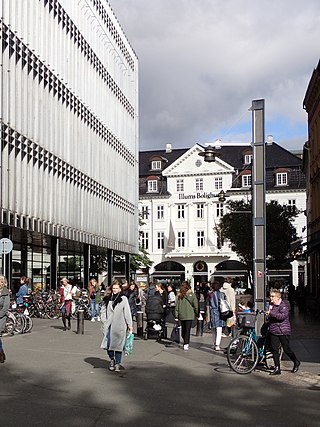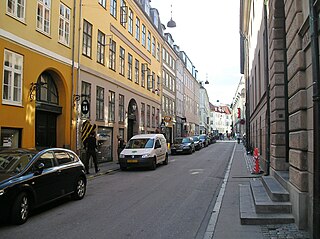Vestergade (Danish: West Street) may refer to:
- Vestergade, Aarhus, a street in Aarhus, Denmark
- Vestergade, Copenhagen, a street in Copenhagen, Denmark
Vestergade (Danish: West Street) may refer to:

Midtbyen, also known as Aarhus Center or City, is the inner part of Aarhus. Midtbyen is part of district Aarhus C, mainly with postal code 8000, together with Vesterbro, Nørre Stenbro Trøjborg and Frederiksbjerg and has a population of around 90000

Vilhelm Theodor Walther was a Danish architect and Royal Building Inspector for Jutland. He was born in Kongens Lyngby, Denmark and died in Aarhus. He was twice awarded the Academy's Neuhausen Prize for excellence in architecture and in 1885, he received the Cross of Honor of the Order of the Dannebrog. Walther completed a considerable amount of restoration work on the cathedral and St Paul's Church in Aarhus and designed a number of churches in the area. Walther died in Aarhus in 1892 of cholera.

Ny Vestergade is a street in central Copenhagen, Denmark. It runs from Frederiksholms Kanal to Vester Voldgade and together with Christiansborg's riding grounds, Marble Bridge and Dantes Plads forms an axis between Christiansborg's tower in the east and Ny Carlsberg Glyptotek's dome in the west. The National Museum's main entrance is located in the street.

Business- and Agricultural Bank of Jutland is a listed building and a former Danish bank in Aarhus.

Vestergade is a street in central Copenhagen, Denmark, linking Gammeltorv in the northeast with the City Hall Square in the southwest. The street defines the southern boundary of Copenhagen's Latin Quarter. Most of the buildings in the street date from the years after the Copenhagen Fire of 1795.

Mønsted's House is a house and a listed building in Aarhus, Denmark. The house was built in 1810 and was listed on the Danish registry of protected buildings and places by the Danish Heritage Agency on 24 March 1950. The building is situated in the historic Indre by neighborhood on Vestergade across from the Church of Our Lady. The reason for the listing was partly the historical significance and importance of the building and the impact of its former inhabitants.

Aarhus Art Academy is an art school in Aarhus, Denmark. The school resides in a listed building on Vestergade 29 in the old medieval inner city, comprised by the neighborhood of Indre By. The building was listed on the Danish registry of protected buildings and places by the Danish Heritage Agency on 3 December 1924. The school offers a 4-year arts programme and a number of courses in sculpting, painting, design, ceramics, photo and webdesign.

Vestergade is a street in Aarhus, Denmark, which runs east to west from the central square of Store Torv to the city park of Åparken at Carl Blochs Gade, intersecting the main streets of Grønnegade and Vester Allé along its course. Vestergade begins in the Indre By neighborhood and ends in neighborhood of Vesterbro, close to CeresByen. Vestergade has some of the best preserved 18th-century merchant estates in Aarhus and a history of creativity and artistic expression.

Hjalmar Kjær was a Danish architect who worked extensively in Odense and made notable contributions to architecture in Denmark in the 19th and 20th centuries. HJalmar Kjær was the son of soap manufacturer Hans Kjær and Kathrine Rasmussen. He attended a technical college before he was admitted to the preparatory course of the Royal Danish Academy of Fine Arts in 1894 and graduated as an architect in May 1896.

Rudolf Frimodt Clausen was a Danish architect born in Copenhagen on 29 June 1861 to the bishop Johannes Clausen and grandson of the theologian Henrik Nicolai Clausen.

The architecture of Aarhus comprises numerous architectural styles and works from the Middle Ages to present-day. Aarhus has a well-preserved medieval city center with the oldest dwellings dating back to the mid-1500s and some ecclesiastical structures such as St. Clemen's Cathedral and numerous smaller churches that can be traced back to the 1100s. The industrialization of the 19th and 20th centuries left distinctive industrial structures, important National romantic works and some of the best examples of Functionalist architecture in the country. The history of the city as a Viking fort is evidenced in the street layout of the Latin Quarter, the wider Indre By neighborhood testifies to its later role as a Market town and center of commerce while the Frederiksbjerg, Trøjborg and Marselisborg districts showcase the first cohesive urban planning efforts of the early 20th century.

Hartvig Philip Rée was a Jewish-Danish merchant and author who built a large shipping and trade business to become one of the wealthiest people of his time. He created the first Jewish cemetery and synagogue in Aarhus at a time when Jews were frequently discriminated against and the Jewish population was negligible. He published a number of written works, mostly related to Jewish theology but also dealing with broader subjects such as economics.

Vestergade 58 is a listed building in Aarhus, Denmark. The listing includes 6 buildings on Vestergade in Aarhus, in the Indre by neighborhood, The buildings were constructed around 1761 and were listed by the Danish Heritage Agency in 1950. The buildings were originally a merchant's mansion used for trade and storage but in the 1960s it became a cultural focal point in Aarhus as Musikernes Hus.

Immervad, previously Emmervad, is a pedestrian street in Aarhus, Denmark, which runs north to south from Lille Torv to Åboulevarden and Frederiksgade. The alley Sankt Clemens Stræde leads to Immervad from the east. The street is situated in the historic Latin Quarter neighborhood and has existed as a road or street since the Viking Age when it was used as the eastern ford to cross the Aarhus River. Immervad is fairly short at just 110 meters long but it is one of the streets with the most foot traffic in Aarhus. At the southern section of the street is the bridge of Frederiksbroen, the first bridge built to cross the river in the city.

Møllestien is a street in Aarhus, Denmark which runs west to east from Vester Allé to Grønnegade and intersects Møllegade roughly in the middle. The street is situated in the historic Indre By neighborhood and is known for its small houses and cobblestone pavement. The street has existed since before 1300 and the name has been used since the 15th century. The majority of the buildings in the street were constructed between 1870 and 1885.

Aarhus Mølle is a building in Aarhus, Denmark. The mill dates back to at least 1289 but the oldest of the existing buildings are from the 1600s while the main building is from c. 1700. The building complex comprise three buildings; a main building from c. 1700, a stables from the 1600s and a malt mill from 1782. Originally constructed on Vestergade in the Indre by neighborhood it has since been moved to the Old Town Museum where it is now used as the main administrative building and for some museum-related workshops.

Larsbjørnsstræde is a street in the Latin Quarter of central Copenhagen, Denmark. It runs from Vestergade in the south to Sankt Peders Stræde in the north, linking Kattesundet to Teglgårdsstræde. Many of the buildings in the street date from the years after the Copenhagen Fire of 1795 and have been listed on the Danish registry of protected buildings and places.

Tietgensgade is a street in central Copenhagen, Denmark. It runs from H. C. Andersens Boulevard in the northeast to Kvægtorvgade at the Meat-Packing District in the southwest, linking Stormgade in the city centre with Ingerslevsgade and Halmtorvet/Sønder Boulevard in Vesterbro. The street follows the rear side of Tivoli Gardens and Copenhagen Central Station. The viaduct that carries it across the railway tracks at the central station is known as Tietgensbro. A series of staircases and lifts provides direct access from the viaduct to the station platforms.

Kattesundet is a side street to the shopping street Strøget in the Old Town of Copenhagen, Denmark. It runs from Vestergade in the northwest to Lavendelstræde-Slutterigade in the southeast, linking Larsbjørnsstræde with Hestemøllestræde. The buildings that line the southwest side of the street all date from the years after the Copenhagen Fire of 1795. Six of them, No. 2 and No. 10-18, are listed in the Danish registry of protected buildings and places. The other side of the street is dominated by the rear side of Copenhagen Court House and the Anton Rosen Jugendstil Metropol Building from 1908.
V58 or V-58 may refer to: